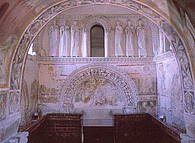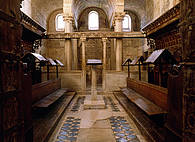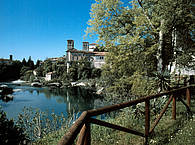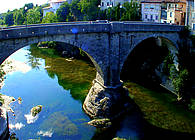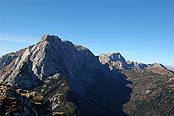Architecture
The Longobard Temple
This is one of the rare surviving examples of Longobard-Carolingian (7th-8th Century) architecture in Italy. Archaeological digs in and around the building have revealed the presence of structures from the Roman and Paleo-Christian eras that were subsequently built on in the early Middle Ages. Inside, on the front wall, are the famous stucco decorations dating from the 8th and 9th Centuries. The chapel is decorated with a series of frescoes of various ages
Roman baths
The public baths, which date from the 2nd Century AD, contained a number of zones with differing functions. The whole complex consisted of the entrance, no longer visible, the changing rooms (apodyterium), of which some traces of the flooring remain, and the frigidarium, tepidarium and calidarium, which were the sections for cold, tepid and hot baths respectively.
Remains of a domus
The Town Hall of Cividale was erected on the remains of a Roman house, or “domus”, of which part of the inner courtyard has been preserved. When built, the house stood along side the cardo massimo (the principal north-south road), which ran along the present-day Via Paolino d’Aquileia. The floor of the main room and corridor was formed from a mosaic of black and white tiles, dating from the 1st Century AD. Medieval and modern building work, still visible, has largely obliterated the original layout of the Roman house.
Ancient fortified town
The City of Cividale closely adheres to the initial Roman layout and subsequent medieval urban arrangements. The original urban centre of Forum Iulii dates from the 1st Century BC. Following the devastating 5th Century barbarian invasions that led to the abandonment and decline of Aquileia, Forum Iulii became the most important city and centre of government of Venetia and Istria. During the subsequent Longobard era it was the seat of the Friulian Duchy, and then fell under Carolingian rule, during which time it was renamed as Civita Austriae. Remnants of the ancient fortified city that can still be seen include the west door of San Pietro, the two east doors of Borgo Brossana, the remains of a number of Venetian keeps and several stretches of wall.
Celtic hypogeum
According to some scholars, the so-called “Celtic Hypogeum”, a cave excavated from the rocky banks of the Natisone, is evidence of a pre-Roman presence, although its origins and original function remain unclear. From the cave three low corridors dug from the rock lead into three rooms. The walls contain niches, shelves and ornamental columns. There are some particularly intriguing sculpted masks above the entrances, similar to the so-called têtes coupées (Celtic masks) found in many funeral sites of southern France.
San Panteleone
The small church of San Pantaleone was built alongside the Late Roman / Early Medieval road that run from Forum Iulii to Cormones and on to Pons Sonti (the Roman bridge over river Isonzo near Gradisca) and the Via Aquileia – Iulia Emona. In the 19th Century it was the focus of archaeological research, and the remains of a building thought to be part of a temple dedicated to Mars were found. A number of burial sites from the Late Roman period were discovered around the building. Fragments of a wall and various Roman objects were found nearby, indicating the earlier existence of a Roman rural villa.
